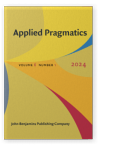Vol. 6:1 (2024) ► pp.1–30
An exploratory study of intonational variation in L1 and L2 English speakers’ pragmatic production of high imposition requests and refusals
This exploratory study examined the intonational patterns and corresponding speech act strategies in L1 and L2 English speakers’ production of high imposition requests and refusals that were elicited using video-based multiple turn discourse completion tasks (DCTs). The participants, 34 L1 American English speakers and 14 high-proficiency L2 English speakers, recorded their oral responses to 10 multiple-turn video-based DCTs. Using Brazil’s (1997) framework, the collected speech samples were analyzed for tone choices in each tone unit. Pragmatic strategies in the produced speech acts were analyzed by adapting the existing coding frameworks (Beebe et al., 1990; Blum-Kulka et al., 1989). The extracted tone choices and lexico-mathematical strategies were compared between the two language groups. The results preliminarily revealed differences in the use of tones by L1 and L2 English speakers in performing requests and refusals. Moreover, while the employed speech act strategies were largely similar between the two speaker groups, the associated tone choices showed contrasting usage patterns.
Article outline
- 1.Introduction
- 2.Literature review
- 2.1Requests and refusals in cross-cultural pragmatic research
- 2.1.1Requests
- 2.1.2Refusals
- 2.2Intonation and L2 pragmatics
- 2.3Intonation and speech acts
- 2.4Research questions
- 2.1Requests and refusals in cross-cultural pragmatic research
- 3.Method
- 3.1Participants
- 3.2Instrument: Multiple-turn discourse completion tasks
- 3.3Instrument presentation
- 3.4Data analysis
- 4.Results
- 4.1Tone choices in requests
- 4.2Tone choices in refusals
- 4.3Lexico-grammatical strategies and tone choices in requests and refusals
- 4.3.1L1 Requests
- 4.3.2L2 requests
- 4.3.3L1 Refusals
- 4.3.4L2 Refusals
- 5.Discussion
- 6.Limitations and future directions
- Acknowledgments
-
References
